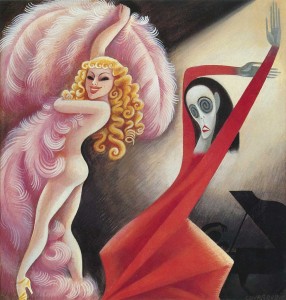
Miguel Covarrubias (1904-1957)|Impossible Interviews: Sally Rand vs. Martha Graham|Illustration for Vanity Fair (December 1934)|Gouache on paper
Dancer/choreographer Martha Graham (1894-1991) established her Center for Contemporary Dance in New York in 1926, and was, by 1934, internationally recognized as the cutting edge in the world of dance performance. By 1934, burlesque dancer Sally Rand (1904-1979) was best known for her infamous appearance at the Chicago World’s Fair, the year before, where she was arrested four times in a single day for indecent exposure. In this imaginative scenario by illustrator Miguel Covarrubias, Sally Rand performs a seductive fan dance next to Martha Graham, who plies her craft in expressive contemporary ballet. The earthy Rand is smiling and curvaceous, painted in warm flesh tones, while the edgy, intellectual Graham, painted in a deathly pallor, assumes a morbid expression and a most un-ladylike pose. The disparity between the two dancers could not be more obvious, and, of course, in reality they would never have found themselves sharing the same stage. Yet it is exactly that polarity that Miguel Covarrubias sought to exploit in this illustration, one of his series of “Impossible Interviews” produced for Vanity Fair magazine between 1931 and 1934.
Covarrubias’ “Impossible Interviews” series traditionally portrayed two contemporary figures from opposite ends of the social, ideological, political or artistic spectrum– personalities who, in reality, would not likely have ever met. The illustrations were accompanied by a brief text by Vanity Fair contributing writer Corey Ford, who provided a humorous hypothetical dialogue between the two characters. Other polar opposites in the “Impossible Interviews” series included John D. Rockefeller Sr. vs. Joseph Stalin (April 1932), Queen Marie of Romania vs. Mae West (June 1932), Chief Justice Charles Evans Hughes vs. Al Capone (October 1932) and Sigmund Freud vs. Jean Harlow (May 1935).
An excerpt from Ford’s accompanying dialogue further underscores the playful tone of Covarrubias’ “Sally Rand vs. Martha Graham”:
SALLY: Hello, Martha. Still doing the same old intellectual strip-tease?
MARTHA: I beg your pardon, Miss Rand, I do not think we have anything in common
SALLY: Forget it, kid, we’re in the same racket, ain’t we? Just a couple of little girls trying to wriggle along.
MARTHA: But my dancing is modern-classical-imaginative. If you leave anything to a customer’s imagination, it’s because he’s near-sighted.
SALLY: Sure, I come right out in the open. I put my best points forward.
Further into the dialogue, it becomes evident that the cultured, respectable Martha Graham is being put on the defensive as lusty, worldly-wise Sally Rand assumes the upper hand. Such was the spirit of the series, in which the “underdog” frequently emerged the winner. On the surface, it may seem like something of a departure for Covarrubias to have chosen two dancers as his antagonists in a series that more regularly showcased disparate social and political opponents; however, a deeper probe into his personal life makes the choice more understandable. Seven years earlier, in 1927, in the midst of his collaborative involvement with numerous Harlem Renaissance musicians, writers and performers, Covarrubias created the stage and costume designs for Josephine Baker’s La Revue Negre, the enormously popular dance revue that established Baker as an international sensation. Furthermore, Covarrubias’ wife, Rosa Rolanda, was herself an accomplished and celebrated dancer. Covarrubias was no stranger to the world of dance; his knowledge of and involvement in it was significant.
The whimsical spirit of Covarrubias’ “Impossible Interviews” series belies its brilliant conceptual format in order to “get the joke,” readers had to be savvy enough to have some knowledge of the antagonists portrayed in the image. Such was the niche that Covarrubias filled in the publishing landscape of his day. His visual style, like his conceptual approach, was smart, spontaneous and bitingly satirical. Those qualities made him a suitable contributor to Vanity Fair magazine, then a small but sophisticated publication which, like the New Yorker, appealed primarily to an informed and urbane demographic.
December 3, 2009
By James Gilbert, Curatorial Staff
Norman Rockwell Museum






